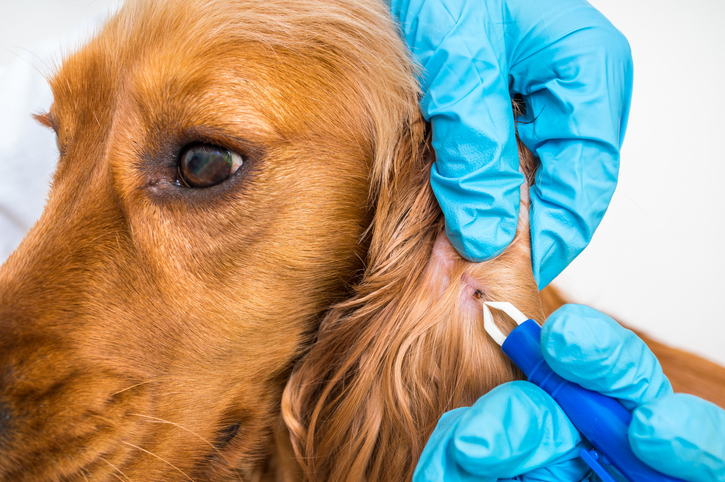This is one question our vets get asked a lot! Your dog’s ears need to be cleaned only as per recommendation of your veterinarian, or when there are signs of an ear problem. In any case, your dog’s veterinarian should always be the one to make the diagnosis and take care of the problem with treatment and any ear cleaning necessary.
What Can I Use to Clean My Dog’s Ears?
This is another frequently asked question we get, and the answer is: not a whole lot, and for a very good reason. It is actually not a good idea to try to clean your dog’s ears yourself; cleaning may not even be necessary.
Let us explain. The cleanliness of your pet’s ears, in general, depends on your dog’s breed, coat, activities, age, and the amount of earwax produced. Your dog’s ears may be floppy, long, short, or stick right up, and there may be a lot of thick hair, or the hair in the ears may be thin and sparse. Whatever it may look like on the outside, however, on the inside, a dog’s ear canal is always L-shaped with vertical and horizontal portions, which makes cleaning difficult. That means you should never take on this job yourself. There is a lot of potential to create a problem when there may be no reason for concern.
A professional groomer will be happy to remove thick hair in the external ear and around the ear canal opening to reduce chances of water or pollutants being trapped inside, but will not venture further into a dog’s ear than a half inch. If your dog displays any symptoms of ear problems, don’t go to a groomer but to your veterinarian for proper diagnosis and treatment.
Many dogs never need to have their ears cleaned. As a pet parent, your job is to make sure your pet’s ears are dried well after swimming or splashing in the water, and to watch for signs and symptoms of ear problems. Your veterinarian can advise you on whether or not your dog’s ears need grooming to keep shaggy hair out of them before the excess hair causes problems.
Ear Problems in Dogs Can be Triggered in Several Ways
There are lots of do-it-yourself (DIY) instructions for cleaning your pet’s ears online, but don’t follow them. It is best that you examine your dog’s ears routinely for discharge or redness and sniff them for odor, and leave the cleaning to an expert. There are too many concerns with taking on this job yourself, including the fact that your dog may not be very cooperative if you try!
Here is why dog ear problems can develop:
- Excessive hair in and around the ears or excessive earwax can make it difficult for your dog’s ears to dry out well after water gets into them.
- Ear mites, a foreign object stuck in the ear, tumours or polyps, or water trapped in the ears can lead to bacterial or yeast infections.
- Ear cleaning too frequently can cause irritation of the skin inside your dog’s ears, which can lead to an infection.
- Ear cleaning with the improper tools, such as a poor cleaning solution or not enough cleaning solution, or Q-tips can all be sources of infections.
- Allergies, hypothyroidism, or a ruptured ear drum can all cause ear problems.
Signs and Symptoms of Dog Ear Problems
Keep in mind that floppy-eared breeds such as basset hounds, retrievers, and spaniels are more prone to ear infections. If this is your dog’s breed, then you should be diligent about checking their ears often. Take your dog to the vet if you notice any of the following signs:
- Excessive ear scratching
- Frequent head shaking or head tilting
- A foul smell from the ears; a strong, very unpleasant smell usually indicates a bacterial infection; a musty smell, like moldy bread, usually means a yeast infection
- Loss of balance or walking in circles
- Discharge from ears that is yellow, brownish, black specked, or bloody
- A scabby or waxy or brownish build up in the ear folds or the ear canal
- Hearing loss
- Ear sensitivity, i.e. the dog avoids having anyone touch their ears
Veterinarians Test for Dog Ear Problems and Treat Them Carefully
Your veterinarian will examine your pet’s ears and may take a sample for further examination under a microscope. Further testing may also be required if the cause of the ear problems are not readily apparent.
The main problem could be affecting the outer ear, but may involve the middle or inner ear as well. Outer ear problems can be treated easily, but when an infection spreads to the middle or inner ear, treatment takes longer and your dog’s balance and hearing can be affected. As well, inner ear infections can cause a lot of pain to dogs.
The usual treatments for infections and other ear problems are:
- Medication, which can be either oral or topical or both, and may be antibiotic or antifungal depending on the problem. A bacterial infection will be treated with an antibiotic. A fungal infection, such as a yeast infection, will be treated with an antifungal medication. Corticosteroids may be used in addition to antibiotic or antifungal medications.
- A veterinary prescription will be needed for pain and possibly steroids for inflammation
- Ear flushing may be recommended by your vet for infections.
- Further testing for allergies or complicated or chronic problems by a dermatologist may be necessary.
If your dog is a very shaggy breed and there is a lot of hair in your pet’s ears, ask your groomer to remove the hair in and around the ear canal. Otherwise, carefully examine your pet’s ears as part of your regular at-home dog ear care program, and wait until you see symptoms of a problem, which may never happen (fingers crossed!).
We cannot state it enough. If you should see any of the symptoms or signs listed above, leave the diagnosis to your veterinarian. If cleaning your dog’s ears is necessary, you can rest assured it will be done correctly and no further problems occur.
Creative Commons Attribution: Permission is granted to repost this article in its entirety with credit to Hastings Veterinary Hospital and a clickable link back to this page.






